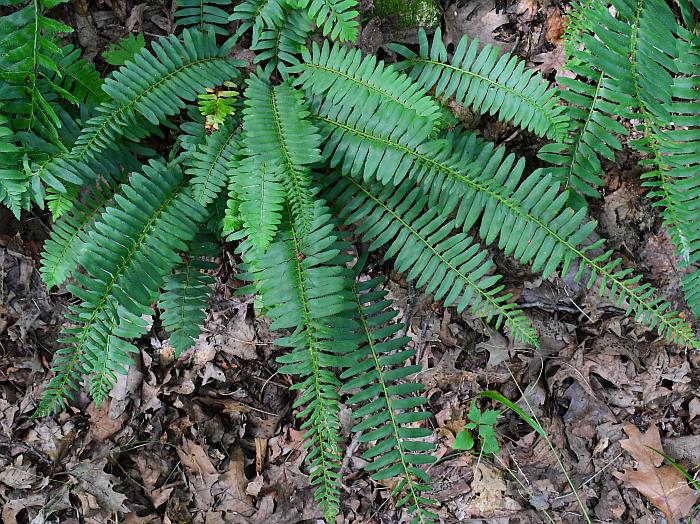Polystichum acrostichoides (Michx.) Schott
Christmas Fern

Native
CC = 5
CW = 3
MOC = 80
© SRTurner
Polystichum acrostichoides (Michx.) SchottChristmas Fern | |
 |
Native CC = 5 CW = 3 MOC = 80 |
© SRTurner |
|
Family - Dryopteridaceae Habit - Fern. Stems - Rhizomes horizontal, prostrate, with long fibrous roots, compact, rarely branched. Scales of rhizomes brownish-orange, ovate to linear-lanceolate. Leaves terminating rhizome. Leaves - Partially dimorphic, the fertile pinnae of otherwise vegetative leaves produced toward the tip of the leaf blade, with somewhat shorter and narrower pinnae than the more basal, vegetative pinnae. Leaves 10-80 cm long, the petioles shorter than the leaf blade, with orange-brown scales, the bases with 4-9 vascular bundles. Leaf blades lanceolate to narrowly oblong in outline, pinnately compound. Pinnae 2-5 cm long, lanceolate to linear, the margins spiny-toothed, usually with an auricle at the base of the upper side. Veins not anastomosing. Rachis scales becoming hair-like near apex of leaf.
Sori - Circular, sometimes covering nearly the entire pinna undersurface. Indusia circular, to 1.5mm in diameter, peltate. Spores 64 per sporangium, monolete, 32-55 μm long, brown.
Flowering - June - October. Habitat - Wooded slopes, in both mesic and dry-mesic forests, most commonly on acidic substrates. Origin - Native to the U.S. Other info. - This species can be found throughout most of Missouri, excepting several counties in the northwestern corner of the state. Its is probably the most common fern seen in the state. It is found throughout the eastern half of the continental U.S., with the western extent of its range following a sharply defined border roughly coincident with Missouri's western border. The leaves recline near the end of the year but remain green throughout the winter. The common name "Christmas Fern" is so given because the plant stays green all year, and because the pinnae resemble small Christmas stockings. American Indians used the rhizomes of the plant to make a tea for chills, fevers, pneumonia, and to induce vomiting. Photographs taken in Brown Summit, NC., 8-13-02 (DETenaglia); also at Meramec Conservation Area, Franklin County, MO, 7-14-2020 (SRTurner). |